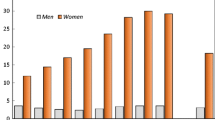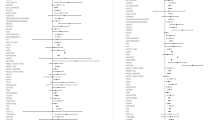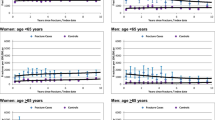Abstract
Summary
The risk of major osteoporotic fracture (MOF) after a first MOF is increased over the whole duration of follow-up, but the imminent risk is even higher. If the acute increment in risk in the few years following MOF is amenable to therapeutic intervention, then immediate short-term treatments may provide worthwhile clinical dividends in a very cost-effective manner.
Introduction
A history of fracture is a strong risk factor for future fractures. The aim of the present study was to determine whether the predictive value of a past MOF for future MOF changed with time.
Methods
The study was based on a population-based cohort of 18,872 men and women born between 1907 and 1935. Fractures were documented over 510,265 person-years. An extension of Poisson regression was used to investigate the relationship between the first MOF and the second. All associations were adjusted for age and time since baseline.
Results
Five thousand thirty-nine individuals sustained one or more MOFs, of whom 1919 experienced a second MOF. The risk of a second MOF after a first increased by 4% for each year of age (95% CI 1.02–1.06) and was 41% higher for women than men (95% CI 1.25–1.59). The risk of a second MOF was highest immediately after the first fracture and thereafter decreased with time though remained higher than the population risk throughout follow-up. For example, 1 year after the first MOF, the risk of a second fracture was 2.7 (2.4–3.0) fold higher than the population risk. After 10 years, this risk ratio was 1.4 (1.2–1.6). The effect was more marked with increasing age.
Conclusions
The risk of MOF after a first MOF is increased over the whole follow-up, but the imminent risk is even higher. If the acute increment in risk in the few years following MOF is amenable to therapeutic intervention, then immediate short-term treatments may provide worthwhile clinical dividends in a very cost-effective manner, particularly in the elderly.


Similar content being viewed by others
References
Johnell O, Kanis JA, Oden A et al (2004) Fracture risk following an osteoporotic fracture. Osteoporos Int 15:175–179
Hansen L, Petersen KD, Eriksen SA et al (2015) Subsequent fracture rates in a nationwide population-based cohort study with a 10-year perspective. Osteoporos Int 26:513–519
Kanis JA, Johnell O, De Laet C et al (2004) A meta-analysis of previous fracture and subsequent fracture risk. Bone 35:375–382
Haentjens P, Johnell O, Kanis JA et al (2004) Gender-related differences in short and long-term absolute risk of hip fracture after Colles’ or spine fracture: Colles’ fracture as an early and sensitive marker of skeletal fragility in men. J Bone Miner Res 19:1933–1944
Klotzbuecher CM, Ross PD, Landsman PB, Abbott TA 3rd, Berger M (2000) Patients with prior fractures have an increased risk of future fractures: a summary of the literature and statistical synthesis. J Bone Miner Res 15:721–739
Johnell O, Oden A, Caulin F, Kanis JA (2001) Acute and long term increase in fracture risk after hospitalization for vertebral fracture. Osteoporos Int 12:207–214
Giangregorio LM, Leslie WD (2010) Manitoba bone density program. Time since prior fracture is a risk modifier for 10-year osteoporotic fractures. J Bone Miner Res 25:1400–1405
Dretakis KE, Dretakis EK, Papakitsou EF, Psarakis S, Steriopoulos K (1998) Possible predisposing factors for the second hip fracture. Calcif Tissue Int 62:366–369
Nymark T, Lauritsen JM, Ovesen O, Rock ND, Jeune B (2006) Short timeframe from first to second hip fracture in the Funen County Hip Fracture Study. Osteoporos Int 17:1353–1357
Lindsay R, Silverman SL, Cooper C et al (2001) Risk for new vertebral fracture in the year following a fracture. JAMA 285:320–323
van Geel TA, van Helden S, Geusens PP, Winkens B, Dinant GJ (2009) Clinical subsequent fractures cluster in time after first fractures. Ann Rheum Dis 68:99–102
Kanis JA, Oden A, Johnell O, Jonsson B, de Laet C, Dawson A (2001) The burden of osteoporotic fractures: a method for setting intervention thresholds. Osteoporos Int 12:417–427
Hernlund E, Svedbom A, Ivergård M et al (2013) Osteoporosis in the European Union: medical management, epidemiology and economic burden. A report prepared in collaboration with the International Osteoporosis Foundation (IOF) and the European Federation of Pharmaceutical Industry Associations (EFPIA). Arch Osteoporos 8:136
Bjornsson G, Bjornsson OJ, Davidsson D et al (1982) Report abc XXIV. Health survey in the Reykjavik area—women. Stages I-III, 1968–1969, 1971–1972 and 1976–1978. Participants, invitation, response etc. The Icelandic Heart Association, Reykjavík
Bjornsson OJ, Davidsson D., Olafsson H et al. (1979) Report XVIII. Health survey in the Reykjavik area—men. Stages I–III, 1967–1968, 1970–1971 and 1974–1975. Participants, invitation, response etc. The Icelandic Heart Association, Reykjavík
Siggeirsdottir K, Aspelund T, Sigurdsson G et al (2007) Inaccuracy in self-report of fractures may underestimate association with health outcomes when compared with medical record based fracture registry. Eur J Epidemiol 22:631–639
Breslow NE, Day NE (1987) Statistical methods in cancer research. IARC Scientific Publications No 32 II:131–135
Ismail AA, Cockerill W, Cooper C et al (2001) Prevalent vertebral deformity predicts incident hip though not distal forearm fracture: results from the European Prospective Osteoporosis Study. Osteoporos Int 12:85–90
Ryg J, Rejnmark L, Overgaard S, Brixen K, Vestergaard P (2009) Hip fracture patients at risk of second hip fracture: a nationwide population-based cohort study of 169,145 cases during 1977-2001. J Bone Miner Res 24:1299–1307
Center JR, Bliuc D, Nguyen TV, Eisman JA (2007) Risk of subsequent fracture after low-trauma fracture in men and women. JAMA 297:387–394
Kanis JA, McCloskey EV, Johansson H, Cooper C, Rizzoli R, Reginster J-Y, on behalf of the Scientific Advisory Board of the European Society for Clinical and Economic Aspects of Osteoporosis and Osteoarthritis (ESCEO) and the Committee of Scientific Advisors of the International Osteoporosis Foundation ( IOF) (2013) European guidance for the diagnosis and management of osteoporosis in postmenopausal women. Osteoporos Int 24:23–57
Bischoff Ferrari HA, Dawson Hughes B, Willett WC et al (2004) Effect of vitamin D on falls: a meta-analysis. JAMA 291:1999–2006
Helden van S, Wyers CE, Dagnelie PC et al (2007) Risk of falling in patients with a recent fracture. BMC Musculoskelet Disord 8:55
Bonafede M, Shi N, Barron R, Li X, Crittenden DB, Chandler D (2016) Predicting imminent risk for fracture in patients aged 50 or older with osteoporosis using US claims data. Arch Osteoporos 11:26. doi:10.1007/s11657-016-0280-5
Acknowledgements
We thank the participants in the Reykjavik Study for their valuable contribution.
Author information
Authors and Affiliations
Corresponding author
Ethics declarations
The study was approved by the National Bioethics Committee and the Data Protection Authority in Iceland. All participants gave informed written consent.
Conflicts of interest
None.
Rights and permissions
About this article
Cite this article
Johansson, H., Siggeirsdóttir, K., Harvey, N.C. et al. Imminent risk of fracture after fracture. Osteoporos Int 28, 775–780 (2017). https://doi.org/10.1007/s00198-016-3868-0
Received:
Accepted:
Published:
Issue Date:
DOI: https://doi.org/10.1007/s00198-016-3868-0




